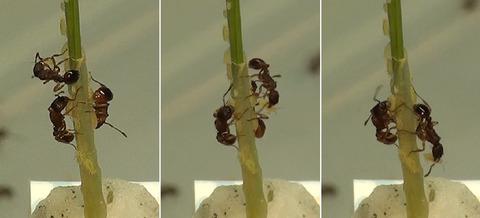当前位置:
X-MOL 学术
›
Entomol. Exp. Appl.
›
论文详情
Our official English website, www.x-mol.net, welcomes your feedback! (Note: you will need to create a separate account there.)
Quarantining behaviour in ants: are Myrmica aphid milkers able to detect and get rid of fungus‐contaminated aphids?
Entomologia Experimentalis et Applicata ( IF 1.9 ) Pub Date : 2020-10-29 , DOI: 10.1111/eea.12985 Tatiana A. Novgorodova 1
Entomologia Experimentalis et Applicata ( IF 1.9 ) Pub Date : 2020-10-29 , DOI: 10.1111/eea.12985 Tatiana A. Novgorodova 1
Affiliation

|
Fungal infections are highly dangerous for social insects including ants. Close trophobiotic interaction between ants and aphids promotes infection transmission, as aphids can be a disease vector. The ability of ants to detect fungus‐infected aphids and get rid of them is important to the prosperity of both symbiotic partners. However, the diversity of quarantining behaviour among ants is still poorly studied. Here, the behaviour of honeydew foragers of two ant species – Myrmica rubra L. and Myrmica scabrinodis Nylander (Hymenoptera: Formicidae, Myrmicinae, Myrmicini) – was studied in laboratory towards Schizaphis graminum (Rondani) (Hemiptera: Aphididae, Aphidini) aphids contaminated with the generalist fungal pathogen Beauveria bassiana (Balsamo‐Crivelli) Vuillemin (Hypocreales). This fungus attacks a wide range of hosts including aphids and ants. The removal of conidia‐contaminated aphids from the host plant was found not to be typical of the ants studied. Aphid milkers of M. rubra and M. scabrinodis usually displayed non‐aggressive behaviour (tolerance, antennation, honeydew collection, grooming) towards the experimental aphids regardless of whether they were covered with conidia or not. Neither ant species, nor the number of milkers had significant effects on their behaviour towards ‘infected’ aphids. However, some individuals were found to demonstrate quarantining behaviour in full. They quickly detected and removed contaminated aphids, placing them at some distance from the plant. Moreover, in addition to the simple carrying of ‘infected’ aphids down, the more effective technique of dropping them from the plant was noted as well. Ants of the genus Myrmica appear to have a tendency to perform a certain sequence of actions to remove conidia‐contaminated aphids from the plant. It is likely that in larger colonies or under conditions of increased risk of infection with entomopathogenic fungi, some Myrmica ants are able to deploy and actively use the behavioural pattern of quarantining behaviour to increase their viability.
中文翻译:

蚂蚁的隔离行为:Myrmica 蚜虫挤奶器是否能够检测并清除受真菌污染的蚜虫?
真菌感染对包括蚂蚁在内的群居昆虫来说是非常危险的。蚂蚁和蚜虫之间的密切滋养相互作用促进了感染传播,因为蚜虫可能是疾病的载体。蚂蚁检测被真菌感染的蚜虫并消灭它们的能力对于共生伙伴的繁荣很重要。然而,蚂蚁之间隔离行为的多样性仍然缺乏研究。在这里,两种蚂蚁物种的蜜露觅食者的行为——Myrmica rubra L. 和 Myrmica scabrinodis Nylander(膜翅目:蚁科、Myrmicinae、Myrmicini)——在实验室中研究了 Schizaphis graminum(Rondani)(半翅目:蚜科,被蚜虫污染)通才真菌病原体 Beauveria bassiana (Balsamo-Crivelli) Vuillemin (Hypocreales)。这种真菌攻击范围广泛的宿主,包括蚜虫和蚂蚁。发现从寄主植物中去除被分生孢子污染的蚜虫不是所研究的蚂蚁的典型特征。M. rubra 和 M. scabrinodis 的蚜虫挤奶者通常对实验蚜虫表现出非攻击性行为(耐受、触角、蜜露收集、梳理),无论它们是否被分生孢子覆盖。无论是蚂蚁种类还是挤奶工的数量,都对它们对“受感染”蚜虫的行为没有显着影响。但是,发现有些人完全表现出隔离行为。他们迅速发现并清除了受污染的蚜虫,将它们放置在离植物一定距离的地方。此外,除了简单地携带“受感染”的蚜虫,还注意到了将它们从植物中丢弃的更有效技术。Myrmica 属的蚂蚁似乎倾向于执行特定顺序的动作以从植物中去除被分生孢子污染的蚜虫。很可能在较大的群体中或在感染昆虫病原真菌的风险增加的情况下,一些 Myrmica 蚂蚁能够部署并积极使用隔离行为的行为模式来提高其生存能力。
更新日期:2020-10-29
中文翻译:

蚂蚁的隔离行为:Myrmica 蚜虫挤奶器是否能够检测并清除受真菌污染的蚜虫?
真菌感染对包括蚂蚁在内的群居昆虫来说是非常危险的。蚂蚁和蚜虫之间的密切滋养相互作用促进了感染传播,因为蚜虫可能是疾病的载体。蚂蚁检测被真菌感染的蚜虫并消灭它们的能力对于共生伙伴的繁荣很重要。然而,蚂蚁之间隔离行为的多样性仍然缺乏研究。在这里,两种蚂蚁物种的蜜露觅食者的行为——Myrmica rubra L. 和 Myrmica scabrinodis Nylander(膜翅目:蚁科、Myrmicinae、Myrmicini)——在实验室中研究了 Schizaphis graminum(Rondani)(半翅目:蚜科,被蚜虫污染)通才真菌病原体 Beauveria bassiana (Balsamo-Crivelli) Vuillemin (Hypocreales)。这种真菌攻击范围广泛的宿主,包括蚜虫和蚂蚁。发现从寄主植物中去除被分生孢子污染的蚜虫不是所研究的蚂蚁的典型特征。M. rubra 和 M. scabrinodis 的蚜虫挤奶者通常对实验蚜虫表现出非攻击性行为(耐受、触角、蜜露收集、梳理),无论它们是否被分生孢子覆盖。无论是蚂蚁种类还是挤奶工的数量,都对它们对“受感染”蚜虫的行为没有显着影响。但是,发现有些人完全表现出隔离行为。他们迅速发现并清除了受污染的蚜虫,将它们放置在离植物一定距离的地方。此外,除了简单地携带“受感染”的蚜虫,还注意到了将它们从植物中丢弃的更有效技术。Myrmica 属的蚂蚁似乎倾向于执行特定顺序的动作以从植物中去除被分生孢子污染的蚜虫。很可能在较大的群体中或在感染昆虫病原真菌的风险增加的情况下,一些 Myrmica 蚂蚁能够部署并积极使用隔离行为的行为模式来提高其生存能力。


























 京公网安备 11010802027423号
京公网安备 11010802027423号